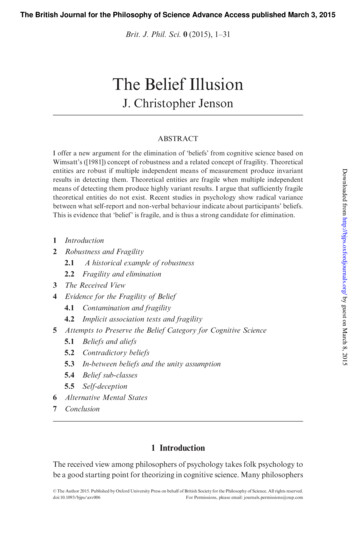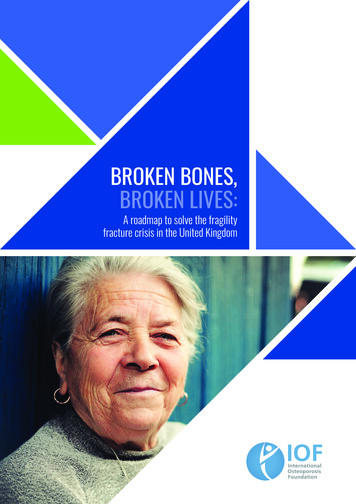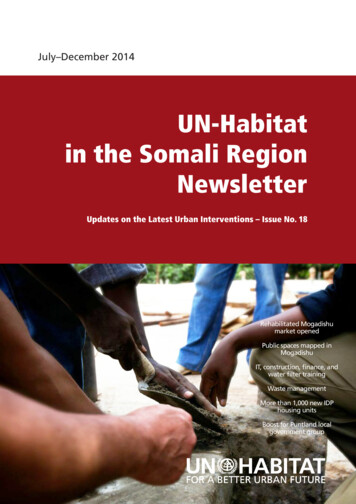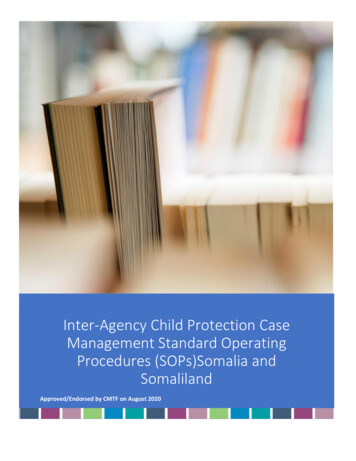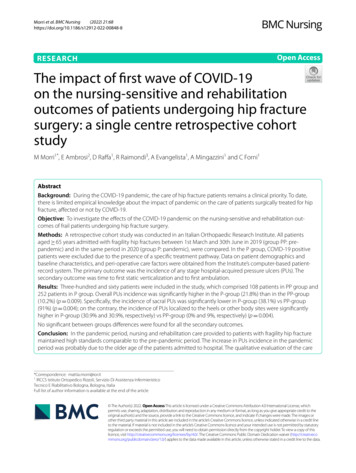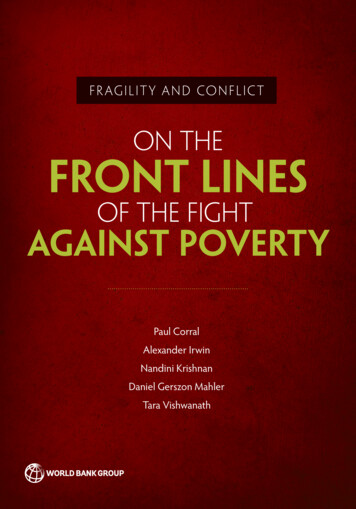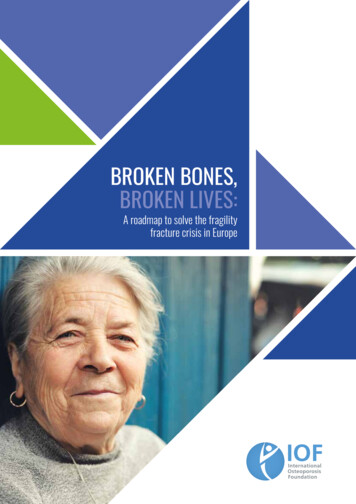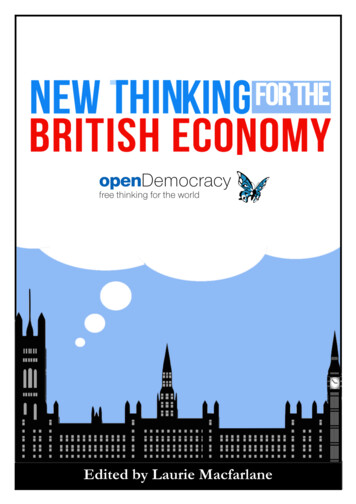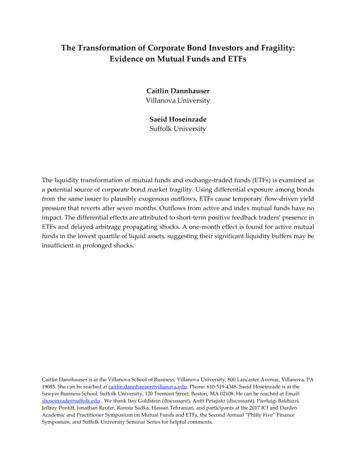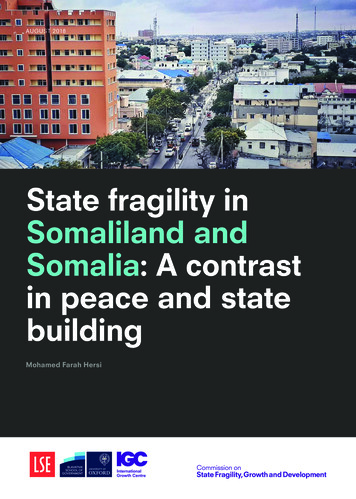
Transcription
AUGUST 2018State fragility inSomaliland andSomalia: A contrastin peace and statebuildingMohamed Farah Hersi
Mohamed Farah Hersi is the Director of the Academy for Peace andDevelopment in Hargeisa, SomalilandAbout the commissionThe LSE-Oxford Commission on State Fragility, Growth and Development waslaunched in March 2017 to guide policy to combat state fragility.The commission, established under the auspices of the International GrowthCentre, is sponsored by LSE and University of Oxford’s Blavatnik School ofGovernment. It is funded from the LSE KEI Fund and the British Academy’sSustainable Development Programme through the Global Challenges ResearchFund.Front page image: Mohamed958543 Wikipedia2State fragility in Somaliland and Somalia: A contrast in peace and state building
ContentsIntroduction4The rise and fall of pan-Somalism6The nexus between state legitimacy, and security andconflict9Political compromise and conflict: Undermining stateeffectiveness13Risky business: Private sector development amid insecurity 16Living on the edge with few safety nets19Somali state fragility: Regional and international dynamics 203Conclusion23Bibliography25State fragility in Somaliland and Somalia: A contrast in peace and state building
Introduction14The region inhabited by Somali-speaking people covers the northeast tip ofAfrica. During colonialism, this area was divided between European powers,separating the Somali people into five territories: Italian Somalia (today’sSomalia), British Somaliland (today’s Somaliland), French Somaliland (today’sDjibouti), and notable Somali enclaves in Ethiopia’s Ogaden region and Kenya’sNorth Eastern province.Pan-Somali nationalism long hoped to overcome these colonial divides andunite all Somali peoples in a single nation. Shortly after attaining independence inmid-1960, British Somaliland (hereafter “Somaliland”) opted for unification withSomalia, forming the Somali Republic, in what was the first of several attempts toestablish a united Somalia. As the lesser of the two union partners, Somalilandwas marginalised under the unification venture, prompting civil war. In 1991,after the civil war culminated in the fall of Mohamed Siad Barre’s military regime,Somaliland unilaterally declared independence from Somalia.Since 1991, the state-building trajectories of Somaliland and Somalia havediverged considerably. After a locally-owned and funded, culturally-rooted,bottom-up peacebuilding and state formation process, Somaliland has achievedpeace and stability under a functional but relatively weak government that isconsidered legitimate by its population. Elections have been held regularly andpower transferred peacefully between political rivals several times. Despitenotable state-building success, almost three decades later Somaliland is yet tobe recognised as an independent state by the international community.In contrast, repeated international efforts to stabilise Somalia and establish astrong centralised system of government have yielded little success and Somaliaremains a failed state. Its central government is largely non-functional and haslittle authority and legitimacy in the country. The country’s lawlessness has madeit a breeding ground for terrorism and other illegal activities, including smugglingand piracy, and those who profit from these illicit activities have a vested interestin perpetuating Somalia’s instability.Although commonalities undoubtedly exist across the Somali population,including on aspects of traditional governance and customary norms, thecolonial division of the Somali people into the five separate territories hasbrought about differing experiences of colonialism, post-colonial stateformation, and governance. This varied experience has changed the respectiveSomali societies in important ways, and has put them on different growth anddevelopment trajectories.While Somaliland and Somalia differ notably today, they both exhibit alldimensions of state fragility to varying degrees, experiencing ongoing challengesState fragility in Somaliland and Somalia: A contrast in peace and state building
regarding state legitimacy, security and conflict, state effectiveness, privatesector development, and resilience. These dimensions of state fragility areinterconnected and compound one another in both states. This paper willexamine the various causes and consequences of the drivers of fragility in thesestates, and will draw lessons, where relevant, for post-conflict peacebuilding andstate formation efforts.Photo5 credit: RetlawStateSnellacfragility Flickrin Somaliland and Somalia: A contrast in peace and state building
The rise and fall ofpan-Somalism26Somalia is considered to be one of the most ethnically homogenous countriesin the world, and internal divisions in Somali society fall along clan and subclan lines rather than ethnic lines. The social-political organisation of the Somalipeople historically had no centralised authority, in large part due to Somalis’traditionally nomadic pastoralist society and fierce independence (Kaplan, 2008).In the absence of a central government, social behaviour has been governed bysocietal institutions, the politics of clannism and kinship, and customary normsand values (de Waal, 2015; Kaplan, 2008). This societal structure relies heavily onstrong social networks, a characteristic that remains true of Somali society today(Clapham, 2017).The euphoria of pan-Somalism that led to the unification of Somaliland andSomalia was short lived as almost from the Somali Republic’s inception, theunification project did not go well. The very different administration systemsthat Somaliland and Somalia had inherited from their respective colonial powersdid not make for an easy merger, and their differing size meant that they werenot equal union partners. As the smaller of the unification partners, Somalilandwas marginalised and its capital, Hargeisa, was relegated to a provincialheadquarters, while Mogadishu became the capital of the Somali Republic(Clapham, 2017). Most high-level government positions went to Somalia’sdominant clans, notably the Darood and Hawiye, with Somaliland holding onlyfour out of the 15 cabinet positions in the first unity government (Bulhan, 2008).A year after unification, a constitutional referendum was held in June 1961 tovote on the country’s new constitution. Somalia voted overwhelmingly in favourof the constitution, but Somaliland’s majority opposed it in what was viewed asa public statement of Somaliland’s dissatisfaction with its treatment under theSomali Republic (Bulhan, 2008). However, Somalia’s larger population meant thatsome 90 percent of the total vote was in favour of the constitution (AED, n.d.). InDecember 1961, Somaliland army officers attempted a coup, which was quicklyquashed (Trunji, 2016). These incidents demonstrated Somaliland’s growingdiscontent with Somali unification.Despite the difficulties that Somaliland was experiencing under the unificationproject, shortly after Kenya’s independence in 1963, Somalis in Kenya’s NorthernFrontier District (today’s Northeastern Province) began to wage a secessionistbattle against the Kenyan government in what became known as the Shifta War(Clapham, 2017). The Kenyan-Somali secessionists wanted the Northern FrontierState fragility in Somaliland and Somalia: A contrast in peace and state building
District to unify with Somalia. Although the Somali government initially backedthe secessionists, after signing a ceasefire deal with the Kenyan governmentin 1967, it withdrew its support and the war eventually petered out, leaving theNorthern Frontier District and its Somali population as part of Kenya (wa Njeri,2015).French Somaliland was notably less eager to join the Somali unificationproject. In a 1967 referendum, French Somaliland opted to maintain itsassociation with France, and in 1977 it become an independent state, Djibouti,rather than join the Somali union which was, at the time, under military rule.In 1969, Barre had seized control of the SomaliAfter years ofRepublic in a military coup. Initially, Barre’s regimeundertook some popular reforms, includingbeing politicallyimprovements in education, healthcare, and women’sand economicallyrights (Kaplan, 2008). However, over time, the militarydisadvantaged and notregime became increasingly oppressive and dismantledhaving their concernsall civilian government institutions, including parliament,and suspended the constitution, banned politicaladdressed by Somalia,parties, and imprisoned politicians (Rashid, 2015).distrust betweenPursuing lingering pan-Somalism dreams, Barre’sSomaliland and Somaliasocialist military regime invaded Ethiopia in 1977 in angrew and the politicalattempt to annex the Somali-dominated Ogaden region.Cold War dynamics influenced the Ogaden War too,environment becamewith the US supporting Somalia while the USSR backedincreasingly hostileEthiopia. The Somali army was eventually driven outby Ethiopia, and Somalia’s humiliating defeat testedthe legitimacy of Barre’s military regime and internal political factions began tochallenge his rule.After years of being politically and economically disadvantaged and nothaving their concerns addressed by Somalia, distrust between Somaliland andSomalia grew and the political environment became increasingly hostile (Rashid,2015). Somaliland’s grievances culminated in the launch of the Isaaq-dominatedSomali National Movement (SNM) in London in 1981. The SNM’s goal was tooverthrow Barre’s military regime and restore Somaliland’s sovereignty. Otherclan-based movements opposing Barre were also established, including theSomali Salvation Democratic Front (SSDF) in Puntland and the United SomaliCongress (USC) in Somalia (Rashid, 2015).A decade-long civil war against Barre’s regime ensued, and governmentforces waged a violent campaign against Somaliland. Systematic bombing ofHargeisa in 1988 devastated the city and may have killed up to 60,000 people (deWaal, 2015). Many thousands of Somalilanders fled to neighbouring countries,notably Ethiopia, Djibouti, and Yemen. During this civil war, genocide, war crimes,and crimes against humanity were committed by the military regime againstthe people of Somaliland (Hersi, 2008). The brutality of the civil war cementedSomaliland’s hostility toward Mogadishu and led to Somaliland breaking awayfrom the union (Clapham, 2017). With all illusions of pan-Somalism gone uponBarre’s fall in 1991, Somaliland’s elders and the SNM’s central committeedecided unilaterally to dissolve the union, and declared Somaliland independent.Since 1991, Somaliland and Somalia’s growth and development paths havediverged considerably as different state formation approaches were pursued in7State fragility in Somaliland and Somalia: A contrast in peace and state building
these states. Today, they serve as informative comparative studies of fragility andstate-building, and they offer a number of critical lessons for governments andthe international community regarding state-building in fragile states.The dynamics of state fragility in Somaliland and Somalia differ, but in bothstates, the dimensions of fragility are interconnected and compound one another.State legitimacy and security and conflict challenges are notably interrelatedin the Somali context. These fragility aspects impact the other challenges offragility, namely state effectiveness, private sector development, and resilience,and are, in turn, also impacted by them. These drivers of state fragility and theirinterconnection will be explored below, with the experiences of Somaliland andSomalia being compared and contrasted.Photo credit: AMISOM Flickr8State fragility in Somaliland and Somalia: A contrast in peace and state building
The nexusbetween statelegitimacy, andsecurity andconflict3There are a number of reasons for the collapse of the Somali state, but colonialgovernance systems and subsequent post-colonial state formation processeshave been a key source of Somalia’s conflict and fragility. Here, it is importantto bear in mind the unique dynamics of Somali society, particularly its historicallack of centralised political authority and its clan-based governance reliant onconsultation and consensual decision-making.During colonial times, British Somaliland was a protectorate, with Britishcontrol over the territory being little more than a paper claim. In practice, thismeant minimal overt colonial interference or interruption of traditional structuresand systems. As a result, traditional institutions remained functional and relativelyunimpeded.In contrast, Somalia’s colonisation by the Italians was far more profound. Acolonial administration of direct rule was established, the number of Italians livingin Somalia rose, and a degree of assimilation of Somalis into Italian culture waspursued. Consequently, traditional Somali structures and systems were disruptedand undermined, and were superseded by a colonial centralised governmentstructure modeled on Italy’s system.Somaliland: Achieving peace and statelegitimacy through political compromiseAfter declaring its independence from Somalia, Somaliland’s peacebuilding andstate formation efforts were driven by traditional Somali norms of governance,notably consultation and consensual decision-making, and informed by9State fragility in Somaliland and Somalia: A contrast in peace and state building
customary values (Kaplan, 2008). Somaliland’s society-led approach allowedfor broad participation and bottom-up democratisation, and establishment oflocally-relevant government institutions that have achieved a high degree ofsocietal cohesion and state legitimacy (Kaplan, 2008).At independence, Somaliland installed a SNM government, led by SNMcentral committee chair Abdirahman Ahmed Ali Tuur. Tuur’s governmentwas given a limited mandate to lead the first two years of post-war statereconstruction and was tasked with establishing security within Somaliland’sborders, ensuring political accommodation of all clans, rebuilding governmentinstitutions, drafting a constitution, revitalising the economy, and restoring basicservices (Bradbury, 2008).By 1993, when the SNM government’s mandate ended, ongoing securitychallenges meant Tuur’s government had made little progress with addressingthese state-building priorities. At an inter-clan conference held in Borama,Mohamed Ibrahim Egal, a compromise non-SNM candidate, was elected to leada new civilian government. Egal’s government inherited a plethora of challenges:inter-clan conflict and mistrust, disruption of imports and exports (particularlylivestock exports), insecurity and lawlessness, dysfunctional governmentinstitutions, negligible government revenue, a significant post-war financial crisis,and urban infrastructure challenges (Bradbury, 2008).Establishing security and law and order was Egal’s chief priority. During thesecurity stabilisation process he introduced, there were several incidences ofinter-clan conflict. There had been political differences among Somaliland’sclans prior to the independence declaration as some had supported Barre’sgovernment, while others had supported the SNM. Challenges to Egal’sleadership also emerged, coming mainly from armed clan militias loyal to formerpresident Tuur.A number of inter-clan reconciliation conferences were held throughoutSomaliland to address these inter-clan hostilities, to negotiate politicalsettlements between conflicting parties, and to undertake a national dialogue toachieve consensus on what system of political representation should be adoptedfor the country (Kaplan, 2008). This was a long and uncertain process, aimed atreaching a power-sharing agreement that made peace more profitable for theparties than instability (Clapham, 2017).With no external assistance reaching Somaliland due to non-recognition ofits independence, these conferences were funded by local businessmen andcommunities. Importantly, no one financing source was dominant (de Waal,2015). Following traditional consensus-based decision-making, the result ofthese consultative and participatory conferences was a bottom-up, culturallyrooted, locally-owned and funded peacebuilding and state-building processthat was considered legitimate by the people of Somaliland. As the processwas entirely domestically funded, it also encouraged self-reliance and adistinct Somaliland national identity (Kaplan, 2008). The societal cohesivenessestablished through this process has created the space needed for politicalcompetition to grow (Kaplan, 2008).The political settlements achieved an enabling environment to start Egal’ssecurity stabilisation process, which included disarmament, demobilisation,reintegration of ex-combatants and clan militias, and the formation of a nationalarmy and police force. This enabled Egal to establish a monopoly on the10State fragility in Somaliland and Somalia: A contrast in peace and state building
legitimate use of force within Somaliland’s borders. Thereafter, his governmentshifted to focus on rebuilding government institutions and providing basicservices.In addition to the broadly legitimate, inter-clan governance system developedin Somaliland’s early years, other factors contributing to Somaliland’s statebuilding success included a relatively homogenous population (the population isabout 70 percent Isaaq), a shared fear of Somalia, modest disparities in wealth,and a lack of external interference which strengthened the accountability ofleaders to the people of Somaliland (Kaplan, 2008). The political elites also hadhistorical friendships and trust between one another, which discouraged resortto political violence (Philips, 2013).The nature of Somaliland’s political settlement is, however, essentially anagreed division of economic opportunities between business elites. Politicaland economic inclusivity underpins the fragile and changing balance of powerbetween competing local actors (Philips, 2013). The distribution of economicbenefits heavily influences political processes, including elite bargaining.Aspects of modern state apparatus have been integrated into Somaliland’sgovernance systems in order to overcome some of the more problematicelements of traditional governance, such as clannism (Kaplan, 2008). In 2001, anew democratic constitution was adopted, and a multi-party system replacedthe clan-based traditional governance. Since then, the balance of clan interestshas been re-oriented by inter-party politics. In an effort to minimise clannism, thenew constitution limits the number of political parties to three and requires eachparty to have broad support in each of Somaliland’s six regions, necessitatingforging of inter-clan coalitions (Kaplan, 2008). The government’s ability to deliverpeace and security within Somaliland’s borders is a key factor in its persistinglegitimacy. Business elites continue to control national politics, however, whichhas implications for state effectiveness, among other things.Somalia: Lawlessness and the collapse ofthe central governmentIn contrast, the Western-style centralised system of government imposed onSomalia while it was an Italian colony continued in force post-independence. Astrong centralised government is completely antithetical to Somalis’ traditionalpolitical structures and processes, and this sharp disconnect between traditionaland centralised governance has created a fragile political, social, and economicenvironment in post-colonial Somali state formation.Somalia’s post-war peacebuilding and state-building process took a verydifferent route to that of Somaliland. Following the defeat of Barre’s militaryregime, the United Somali Congress (USC) clan-based militia, which had foughtalongside the SNM to topple Barre, seized control of Mogadishu. Barre’s fallcaused the collapse of Somalia’s government – the central authority of theSomali state disappeared and state institutions stopped functioning. Politicalinstability and inter-clan armed conflicts engulfed Somalia in the immediate postwar period. The USC splintered into two rival clan militias, led by Ali Mahdi andGeneral Aideed, both from the Hawiye clan. Mahdi was elected president of the11State fragility in Somaliland and Somalia: A contrast in peace and state building
centralised government, but his legitimacy was challenged by Aideed and others,who fought for control over Mogadishu.In 1992, a war-induced famine transformed the localised Somali conflict intoan international crisis. Both the US and the United Nations (UN) were prepared tointervene in Somalia to restore peace and stability and to ensure the delivery ofrelief supplies to starving Somalis. The UN Security Council imposed an armsembargo on Somalia in 1992 and established the UN Operation in Somalia(UNSOM), which was later expanded to form the Unified Task Force (UNITAF), aUS-led humanitarian intervention (CRD, 2008). More than 30,000 troops weredeployed to restore law and order, end the famine, and create an enablingenvironment for humanitarian assistance programmes. UNITAF was dissolvedfollowing an externally-sponsored peace process led by Ethiopia, and UNSOMwithdrew from Somalia in 1995 after having failed to accomplish its mission.Nevertheless, the international intervention had failed to reconstitute the Somalistate and Somalia’s conflict continued (CRD, 2008).Subsequent externally-driven and internationallyThe repeated externallyfunded peace processes were attempted, includingin Djibouti (1991 and 2000), Ethiopia (1993 and 1996),driven and fundedand Kenya (2002) (CRD, 2008). These efforts haveattempts to impose ayielded little success in terms of stabilisation andWestern-style centralisedstate formation. The central government has no localgovernment on Somalialegitimacy and only survives because of the protectionand support provided by foreign forces; in turn, thehave not yieldedgovernment lacks accountability to its own people.peace, stability, or localPolitical factions and clan-based militias continue tolegitimacyfight for control. While clan-based militias are seeminglystrong enough to dislodge others, they lack theauthority and legitimacy needed to maintain their control or transform themselvesinto effective governance bodies (Clapham, 2017). Some argue that the externalfunding channeled into Somalia for state-building has had the unintendedconsequence of incentivising and entrenching clan-based militias (Kaplan, 2008).The government institutions and services that do exist are concentrated inMogadishu, with little regional or district-level administrative presence outsidethe capital. After adopting a federal structure in 2004, the state-buildingprocesses of Somalia’s states have further increased the dysfunction of thecentral federal government. Security remains the key challenge, underminingstate-building and service delivery efforts. Somalia’s insecurity, lawlessness, andthe government’s lack of control over the country’s territory makes it vulnerableto terrorism and other illegal activities, including smuggling and piracy.What is clear from the divergent outcomes of peacebuilding and statebuilding in Somaliland and Somalia is that, to achieve local legitimacy andmaintain peace and stability, these approaches must be locally-owned,preferably locally-funded, and should incorporate traditional political structuresand processes, as done in Somaliland. The repeated externally-driven andfunded attempts to impose a Western-style centralised government on Somaliahave not yielded peace, stability, or local legitimacy.12State fragility in Somaliland and Somalia: A contrast in peace and state building
Politicalcompromiseand conflict:Undermining stateeffectiveness4The challenges of state legitimacy and security and conflict in both Somalilandand Somalia have important implications for state effectiveness in these states.Somaliland: Elite capture of the publicsectorSomaliland’s government has been deeply shaped by its political settlement,which was the outcome of negotiations between business elites and politicalleaders. Government institutions are generally operational but fragile, sufferingfrom a lack of technical, political, and financial capacity to implement relevantlaws. Government has succeeded in providing peace and security, but basicservice delivery beyond this is very limited.Some notable institution building has taken place, although many institutionsremain relatively weak. For example, the National Electoral Commission is oneof the more competent institutions in the country, and is viewed as operatinginclusively and transparently (Kaplan, 2008). A civil service commission has beenestablished to train civil servants and improve the capability and professionalismof the civil service sector. However, clan leaders continue to hold considerablepolitical power, which impedes modernisation of Somaliland’s governmentinstitutions and the establishment of a more meritocratic civil service (Kaplan,2008). There also appears to be some incidence of government institutions beingmisused for personal financial and political gains, and government lacks thecapacity and political will needed to address corruption.The Somaliland government’s two main sources of revenue are tax and13State fragility in Somaliland and Somalia: A contrast in peace and state building
indirect development assistance. Without international recognition, Somalilandcannot receive official development assistance or concessional loans frommultilateral financial institutions such as the World Bank and InternationalMonetary Fund (IMF). Although difficult, this situation has ensured a high degreeof accountability as taxation is the primary source of government revenues.However, at 7 percent of GDP (2012 estimate), tax revenues are very limited andconsiderably below the sub-Saharan Africa average of 18 percent (World Bank,2014).Business elites are too powerful vis-à-vis the government for proper regulationor taxation, and attempts by government to adopt or enforce taxation lawsare vociferously resisted by elites owning large firms. Even if firms paid tax,government lacks the capacity needed to audit them to verify accuracy of taxpayments. Dominance by business elites in this manner undermines government’srevenue collection potential. Due to larger firms being non-cooperative withtaxation, tax revenues are derived mainly from small and medium enterprises thatlack the elite influence of larger firms. Harassment and probable over-taxation ofsmaller firms (in proportion to their contribution to the national economy) hampersfirm growth and job creation, and limits formalisation and expansion of industry.As a result of the difficulties of collecting income tax and constrained capacityto collect other taxes categorised as inland tax, such as property tax and businesslicense fees, only 16 percent of revenue comes from inland tax sources, while68 percent of revenues comes from customs taxes and fees (Ahmed, 2018).The sizeable share of customs taxes and fees in total government revenues ischaracteristic of low capacity contexts, where it is often easier for government touse their limited capacity to collect revenues at demarcated border points thanin the economy at large. Service industries, such as telecommunications andfinancial services, which make up a notable share of Somaliland’s GDP, tend toimport and export few goods and therefore incur minimal customs taxes and feesin addition to being able to circumvent inland tax collection. Instead, revenues thatare paid to government by large firms are made on a voluntary basis, likely at levelsbelow what they would be paying if taxes and fees were effectively enforced in atransparent and uniform manner.Low levels of tax revenue starve the government of the financial resourcesneeded to strengthen government institutions and to fund basic service provision.Maintaining security comes with a high price tag – some 31 percent of governmentexpenditure is spent on the security sector, leaving little funding available forprovision of other services (Ahmed, 2018). As a result, almost all other servicedelivery is privatised including water, sanitation, education, health, and electricity.Similarly, many justice and law and order services, including contract enforcement,protection of property rights, and dispute resolution, are provided privately, basedon traditional clan customs (World Bank, 2016).Delivery of these services by the private sector, often by companies that facelittle competition, results in Somalilanders having to contend with higher costsand/or lower quality of services and few (if any) alternative providers if they aredissatisfied. Firms’ vested interests in service provision may also motivate them toundermine government’s ability to deliver basic services, including by not payingtax revenues to the government. It is apparent that reform of the taxation systemwill require considerable political commitment from the government, which willface strong backlash from business elites.14State fragility in Somaliland and Somalia: A contrast in peace and state building
Somalia: No functioning central governmentSomalia’s central government has been largely non-functional since 1991.Government institutions are weak and fragile, and the government lacks thefinancial resources to even pay civil servant salaries, let alone build governmentinstitutions. As in Somaliland, basic services are provided by the private sector.Unlike in Somaliland, however, the government has failed to achieve and maintainpeace and security within the country’s borders. Indeed, al-Shabaab, the mainIslamist militant group active in Somalia, managed to expand their territorialcontrol relatively rapidly at least partly because it was able to supply a measureof law and order in the areas under its control, which was appealing to Somalicommunities after years of chaos (Kaplan, 2008). Where pockets of local-levelpolitical s
traditionally nomadic pastoralist society and fierce independence (Kaplan, 2008). In the absence of a central government, social behaviour has been governed by societal institutions, the politics of clannism and kinship, and customary norms and values (de Waal, 2015; Kaplan, 2008). This societal structure relies heavily on
